Highlights from the
Cos Cob Art Colony Collection

John Henry Twachtman (1853–1902)
Untitled: Old Saltbox, ca. 1895,
Oil on Canvas
Museum purchase, x2000.08
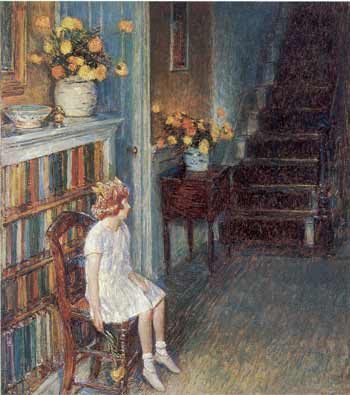
Childe Hassam (1859-1935)
Clarissa, 1912
Oil on canvas
The Historical Society of the Town of Greenwich purchased with funds from Ann K. Arnold, Mr. and Mrs. Harris J. Ashton, Louis C. Baker, Bankers Trust Co. Connecticut Ltd., Mr. and Mrs. Edward H. Bragg, Jr. Martin Edelston, Mr. and Mrs. Thomas M. Evans, Mrs. Agnew Fisher, Mr. and Mrs. Everett Fisher, Mr. and Mrs. Robert B. Goergen, Mr. Brooks Hamoffman, Mr. and Mrs. Frank G. Lyon, Mr. and Mrs. Peter Malkin, Mrs. John Mayer, Mr. and Mrs, Russell S. Reynolds, Jr., Stolt Parcel Tankers Inc. Mr. and Mrs. Edwin Thome, Mr. and Mrs. Hugh B. Vanderbilt, Mr. and Mrs. David W. Wallace, Bernard and Jean Yudain, 1995.03
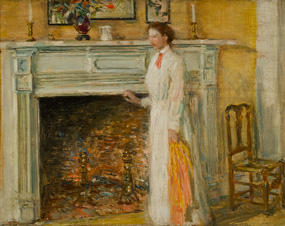
Childe Hassam (1859-1935)
The Mantle Piece, 1912,
Oil on cigar box lid, m
Museum purchase, 2005.05.01
A young girl, unidentified, stands in front of the fireplace in the best bedroom of Bush-Holley House. The chair to the right is still in the collection of the Historical Society.
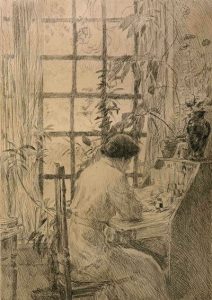
Childe Hassam (1859-1935)
The Writing Desk, 1915
Etching
Museum purchase, x2002.109

George Wharton Edwards (1859-1950)
The Grand Bazaar at Constantinople (Bayuk Tcharchi), 1928-1929
Oil on canvas
Gift of Mr. Norris C. Carter, 1958.11.07
Edwards was a prolific artist, illustrator and writer who produced more than sixty illustrated books. Around 1909 he began to focus most of his time towards writing and illustrating sumptuous gift travel books. In 1928 he traveled to Turkey looking for locales that were exotic to Westerners. Shortly after completing this painting, it was exhibited at New York’s Grand Central Art Galleries and at the National Academy of Design. For his book Constantinople/Istamboul, however, he chose a different view of the vaulted Grand Bazaar.

Walter A. Fitch (1861-1910)
View of the Garden, ca. 1900
Pastel on paper
Gift of Ruth Fitch Mason, 1958.04.02
Fitch began making annual summer visits to Cos Cob in 1900, and was a year-round resident from about 1906 to 1909. He rendered this view, believed to be the Holley House garden, in pastel, a medium whose portability and nature made it particularly well suited to the Impressionist practice of working out of doors, en plein air, and capturing the essence of a place and time.

Ernest Lawson (1873-1939)
A Sunny Morning, North Mianus, Connecticut, ca. 1892
Oil on canvas
Purchased in honor of Claire F. Vanderbilt with donations to the Greenwich Historic Trust, 1999.07
The most famous of the students John Henry Twachtman and Julian Alden Weir taught in their 1892 and 1893 summer classes at Cos Cob was Ernest Lawson. He visited the art colony periodically during the 1890s, and again in 1900 and 1913. While he painted both urban and landscape subjects in New York City, in summer in Cos Cob his focus was limited almost exclusively to landscapes rendered in the Impressionist mode.
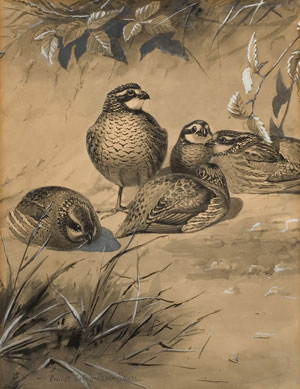
Ernest Thompson Seton (1860-1946)
Quails, ca. 1890
Ink, gray wash heightened with white gouache on paper
William E. Finch, Jr. Archives, Gift of Mrs. Fairchild, 1962
Seton was one of the writers-illustrators who spent time at the Holley House with the painters, writers, publishers, journalists and musicians who frequented the inn. Seton was a self-taught naturalist. He wrote and illustrated scores of books featuring animal heroes and woodcraft skills. He lived in Cos Cob and Greenwich from 1900 to 1930 and established a popular boys camp, at his wooded estate, Wyndygoul, in Cos Cob.
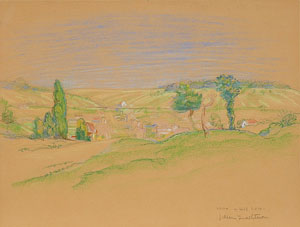
Julian Alden Twachtman (1882-1974)
Vaux & Hill 204, early 20th century
Pastel on paper
Gift of Miss Catherine Baldwin Blanke, D210.01
Julian Alden Twachtman was the oldest son of John Henry Twachtman. An artist in his own right, he studied with his father John Henry Twachtman as well as at the Yale School of Fine Arts and the École des Beaux Arts, Paris.
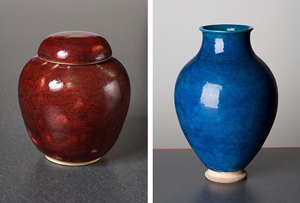
Leon Gambetta Volkmar (1879-1959)
Covered Jar, 1923
Earthenware with Sang de Boeuf glaze, wheel thrown
Museum purchase, 2007.04 a-b
Leon Gambetta Volkmar (1879-1959)
Vase, ca. 1915
Glazed ceramic, wheel thrown
Durant Kiln, Bedford, New York
Gift of John and Henrietta Volkmar, C1971.01.05
Jean Rice, along with her former ceramics teacher Leon Volkmar, founded Durant Kilns. Here Volkmar designed his own kilns and experimented with chemicals and heat leading eventually to the rediscovery of the ancient Chinese, Persian and Egyptian glazes for which he is known. His son recalls that‚ “He used a kick wheel rather than an electric one as he claimed forming delicate pieces was impossible with the electric drive. In later years his varicose veins caused him pain so he had a ‘electric motor’ attached which he used only for centering the piece of clay.” Volkmar visited Greenwich and the Holley House periodically from about 1911. Constant frequently used his vases for her flower arrangements. The Historical Society owns many outstanding examples of his art pottery.
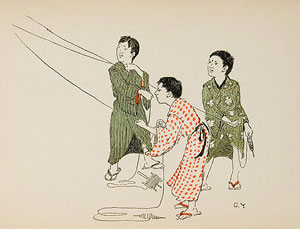
Genjiro Yeto (1867-1924)
Cover and Illustration for Tora’s Happy Day, 1899
Florence Peltier Perry New York: The Alliance Publishing Co.
William E. Finch, Jr. Archives, Holley-MacRae Collection, 1957
Yeto came to the United States in 1890 with the intention of pursuing a career in commerce. In 1895 he enrolled at New York’s Art Students League.The following summer, 1896, he joined Twachtman’s summer class at the Holley House with his close friend Elmer MacRae. Between 1896 and 1901 he spent part of each year at the Holley House. Tora’s Happy Day launched his illustration career. This book was given to Constant before she married Elmer; inscribed on the inside front cover is “Constant Holley, 1899.”